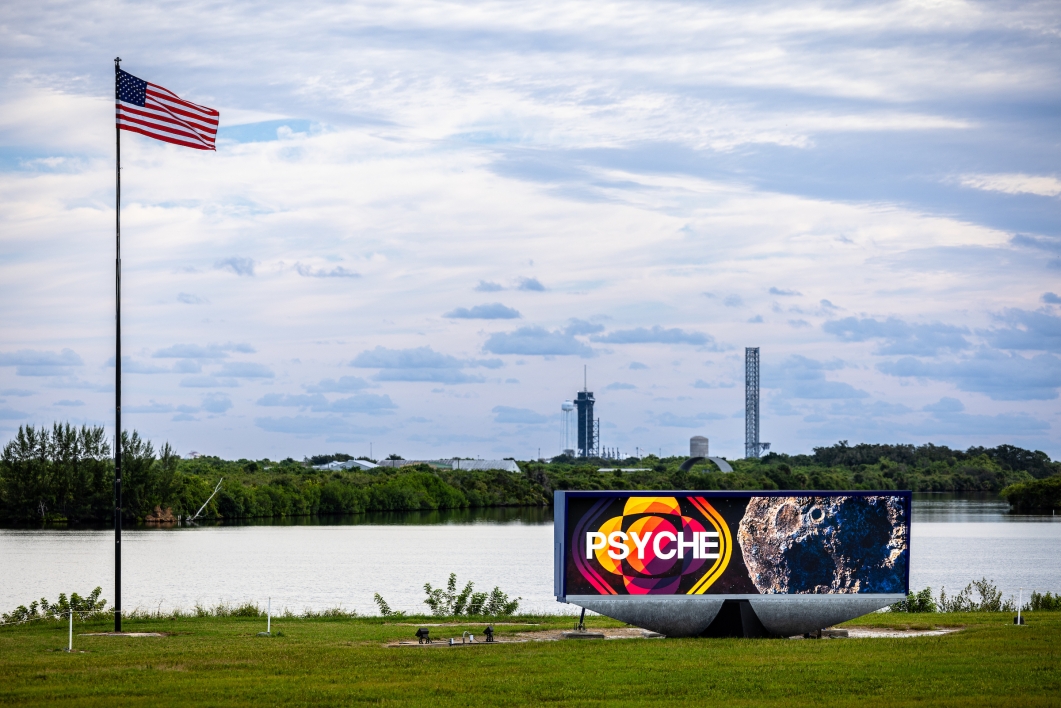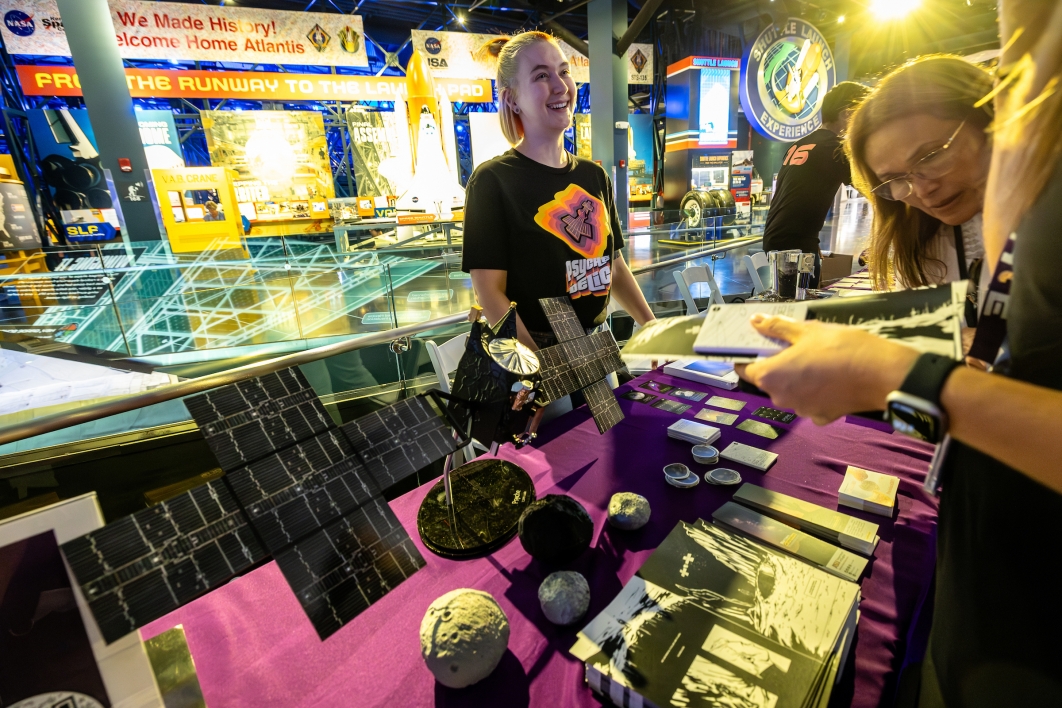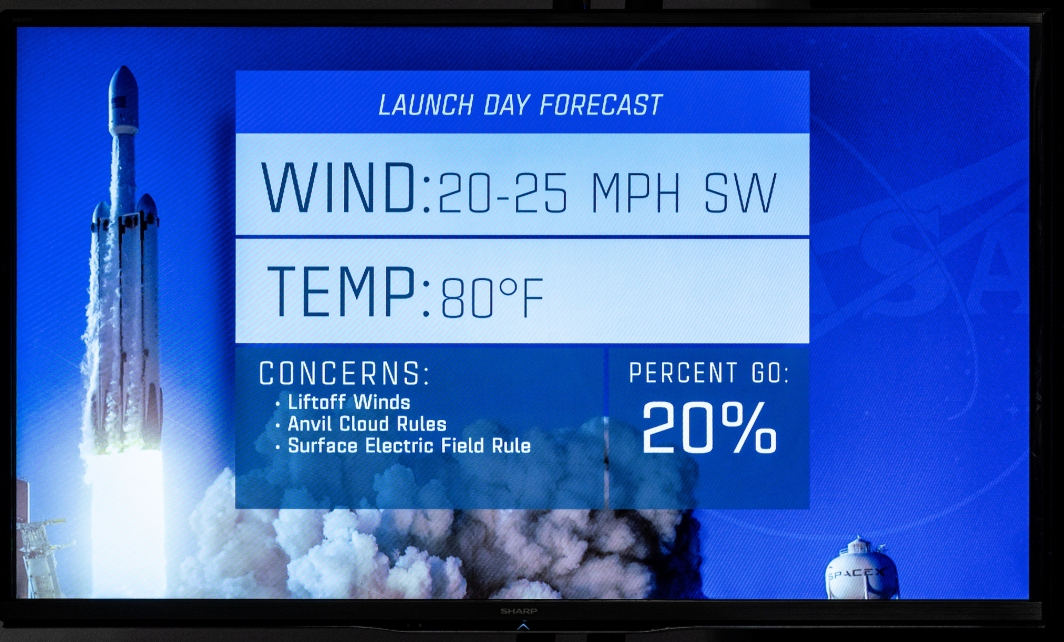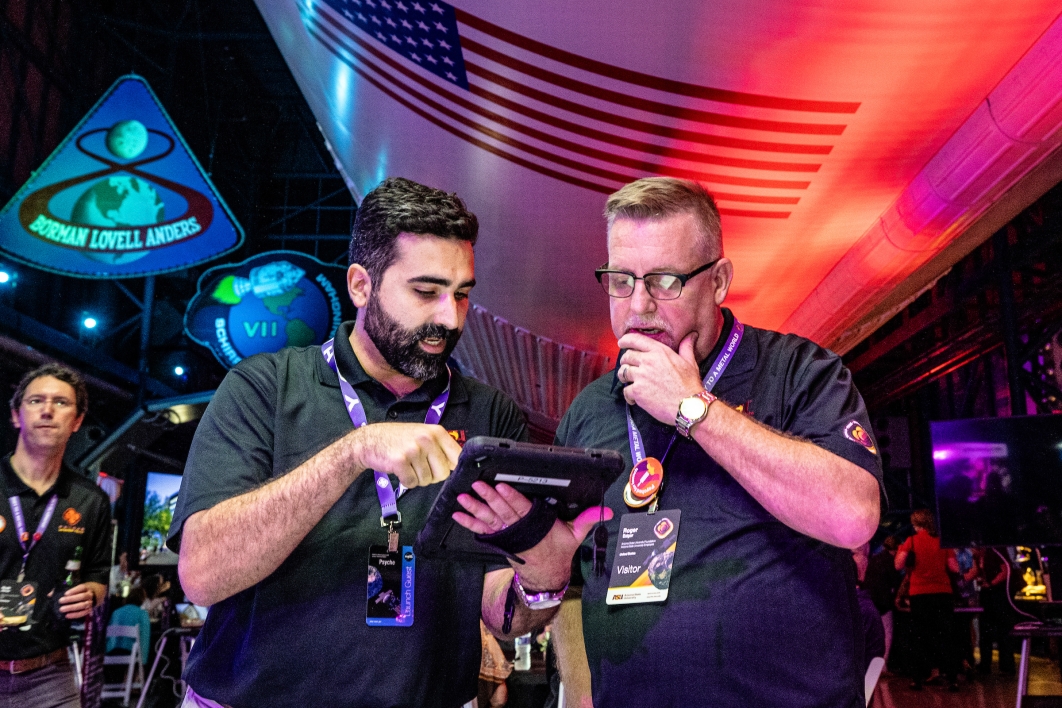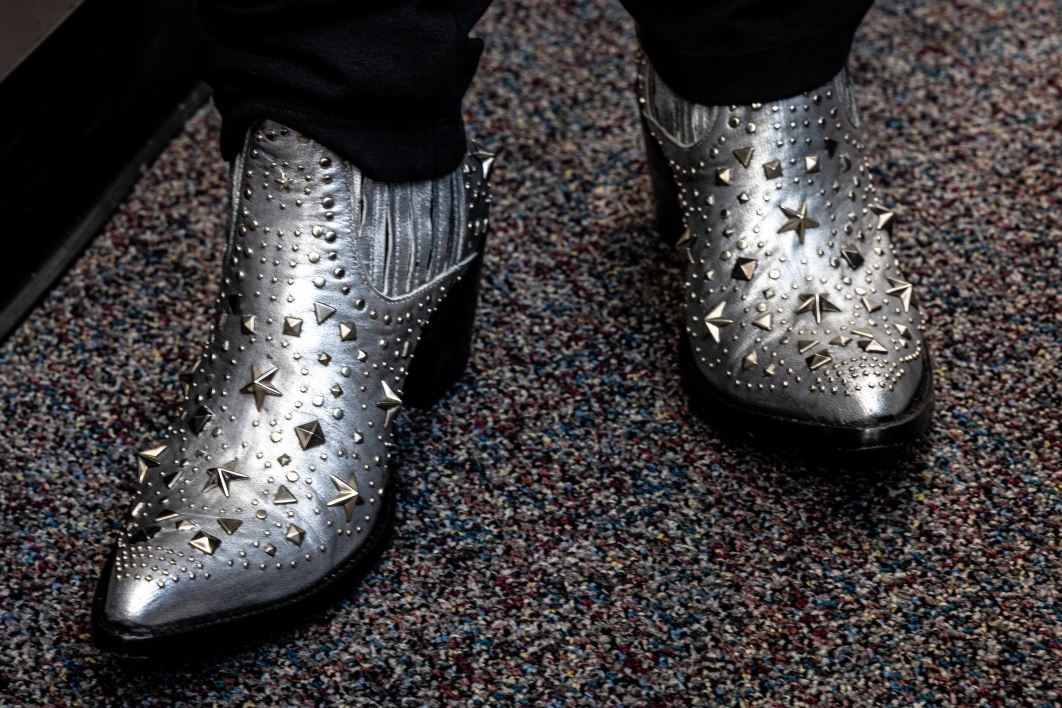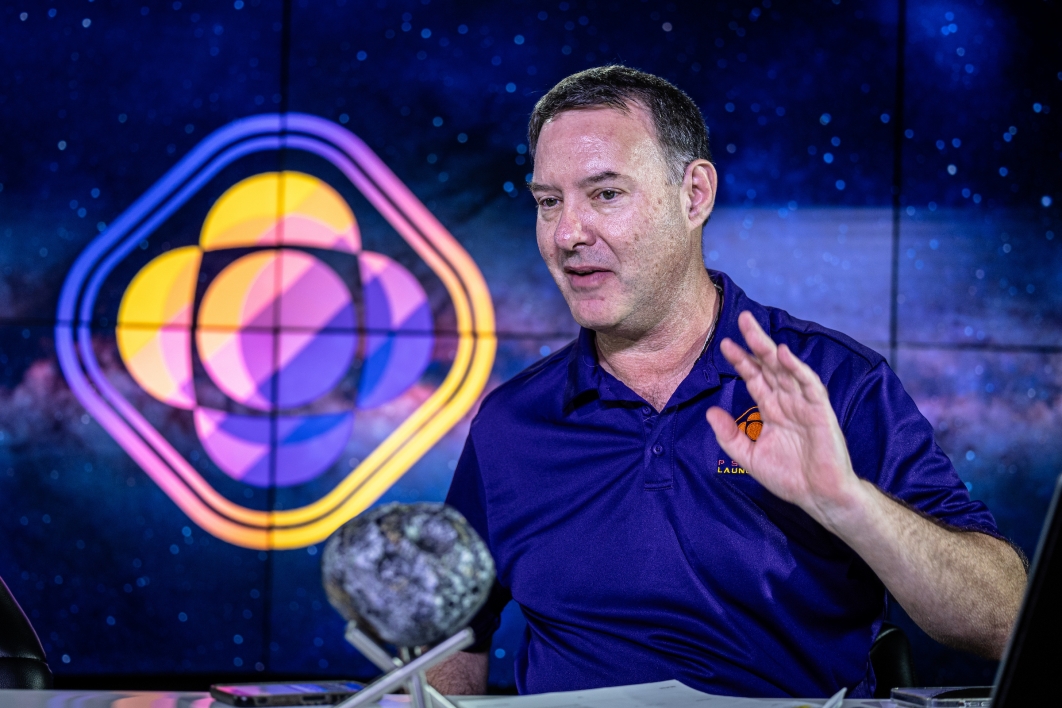A space launch 12 years in the making

The SpaceX Falcon Heavy rocket launches from NASA’s Kennedy Space Center Launch Pad 39A in Florida on Friday, Oct. 13, carrying the Psyche spacecraft, which begins its six-year, 2.2-billion-mile voyage to rendezvous with an asteroid, also called Psyche. (This photo was taken 3.9 miles from the launch pad.) Photo by Charlie Leight/ASU News
Editor’s note: This story is featured in the 2023 year in review.
Friday the 13th — for a space mission beset by challenges — turned out to be a very lucky day indeed.
At precisely 10:19:43 a.m. Eastern on Oct. 13, a SpaceX Falcon Heavy rocket lifted off from NASA’s Kennedy Space Center in Florida, carrying a spacecraft destined for a metal-rich asteroid — a type of world that has never been explored before.
The Psyche mission, the first NASA deep-space mission led by Arizona State University, is a story of perseverance and inspiration, of art and science, and the possibilities of the unknown.
This is the story of one woman. But also, the story of hundreds of people.
This is the story of a world made of metal. Or, perhaps, a world not made of metal.
This is the story of a mission celebrated by Sun Devils near and far, from the ASU California Center to the Barrett & O’Connor Washington Center, and from kindergartners at ASU Prep to retirees on the Tempe campus.
This is the story of a resilient team, led by Principal Investigator Lindy Elkins-Tanton, as they made their way through the final days before a much-anticipated launch — a week of nerves, celebrations and utter awe.
Follow along as we journey through launch week, leading to a momentous milestone for ASU.
Tuesday
Laurie Leshin needed a moment alone, so she moved away from the group, lifted her head and reflected on the wonder above her.
It was approximately 9 a.m. Tuesday morning, and Leshin — an ASU alum and the director of NASA’s Jet Propulsion Laboratory — stood underneath the Psyche spacecraft, reflecting on the journey that brought the Psyche team to this moment.
“I had a little quiet reflection and gratitude for all of the human hands, minds and hearts that have gone into making Psyche a reality,” said Leshin, who was at the launch site with a dozen people, including Elkins-Tanton. “We send robots into space, but they’re built by humans. It’s a very human endeavor.”
An endeavor, Leshin added, that was unlike any other NASA mission because it was interrupted and delayed by the COVID-19 pandemic.
“There is no mission, I think, within NASA that had to grapple with the impacts of COVID more than Psyche,” said Leshin, who graduated from ASU with a bachelor’s degree in chemistry and later was a faculty member in The College of Liberal Arts and Sciences. “Their last review before starting to assemble the spacecraft happened one week before COVID hit and shut everything down. … It’s one of the big reasons that we had to delay the launch by a year.
“So having the team address the issues and now be here today ... it’s incredibly satisfying.”
A few minutes before Leshin spoke, Lori Glaze, director of the Planetary Science Division of NASA’s Science Mission Directorate, described Psyche as “truly a mission of discovery. We are going to visit a place that we’ve never (experienced) before.”
A Psyche display stands next to a U.S. flag at Kennedy Space Center on Oct. 10, with various buildings and the launch site in the background. Photo by Charlie Leight/ASU News
It’s that discovery, that unknown that had Elkins-Tanton smiling during a noon briefing shown on NASA television.
“There aren’t that many completely unexplored types of worlds in our solar system for us to go see,” said Elkins-Tanton, a Regents Professor in ASU’s School of Earth and Space Exploration. “So, that is what is so exciting about this.”
Scientists believe the asteroid could be part of a metal-rich interior of a planetesimal, a building block of a rocky planet. But, as Elkins-Tanton freely admitted, “We don’t know what it’s going to look like. We’re going to be surprised.”
Elkins-Tanton said she has asked scientists all over the world what they expect Psyche to be made of. One person stood up and said, “It’s not the Death Star (from Star Wars) because it’s too small. And it’s not the Death Star prototype because it’s too big.”
“I’ve had so much fun asking that question,” Elkins-Tanton said.
Whatever Psyche is — the metal core of an early planetesimal or material that was formed near the sun — it is sure to mystify and delight Psyche’s team.
“I think there’s a very good chance that it’s going to be outside of our imaginings,” Elkins-Tanton said. “And that is my fondest hope.”
A little more than six miles down the Saturn Causeway and just beyond Kennedy Space Center Visitor Complex’s Orbit Cafe and Milky Way Ice Cream Shop, Psyche Student Collaborations interns staffed tables as part of ASU’s Psyche mission outreach.
At one table, visitors were invited to write a Post-it note saying what they would be doing at different milestones along the Psyche mission timeline. In 2028, one year before the spacecraft is scheduled to begin its first orbit of Psyche, someone wrote, “Mastering a triple standing backflip.” In 2031, upon completion of the mission, Cadet Toney wrote, “I hope to be in the Air Force.”
People could touch a small asteroid model, make a Psyche face mask, see and collect Psyche Inspired artwork in the form of comics and coloring sheets, take home Psyche swag and ask questions of the five ASU Psyche interns who wore Psyche-delic T-shirts with “16” on the back, signifying that Psyche was the 16th asteroid discovered.
“I’m a nerd, so this is fun for me,” said visitor Evan Duggan, a boat builder from Rhode Island. “I’ve been interested in the asteroid for a while. I see it as the next step into space.
“It’s also just fun to talk to people who know about this. Most people don’t.”
Samantha Beauchaine, a third-year ASU student majoring in geological sciences and the lead on @MissionToPsyche’s social media accounts on X (formerly Twitter), Instagram and Facebook, said she had met people from all over the world at the Psyche Student Collaborations exhibit.
“This week has been amazing, just inspiring,” Beauchaine said. “To be around so many people that are into space, and then just teaching others about Psyche. There’s a lot of people who don’t know anything (about Psyche) — it’s just nice to kind of inform them and get them excited about the mission.”
ASU Psyche Student Collaborations intern Samantha Beauchaine, a third-year geological sciences student and the lead on @MissionToPsyche’s social media accounts, talks with visitors at Kennedy Space Center Visitor Complex on Oct. 10 about the impending launch. Photo by Charlie Leight/ASU News
Tristan Tierce, a fourth-year student with a double major in art studies and business entrepreneurship, manages the psyche.asu.edu website and creates the annual coffee-table book for Psyche Inspired, as well as the virtual gallery.
As he looked around at the adults and children stopping by the tables, Tierce said he was blown away by the turnout.
“Walking into the Kennedy Space Center for the first time was really inspiring, and we’ve done a lot of outreach events (in the past), but seeing the amount of people here for this has been really cool,” Tierce said. “I’ve had people come up to the table, English is not their first language, or they don’t even really speak English at all, but we’re able to communicate and give them a little bit of information just through whatever art we have here. That crosses boundaries.”
Psyche’s scheduled launch was still two days away, but as Beauchaine took a moment away from the exhibits to think about the swirl of emotions she would feel at liftoff, her eyes became misty.
“I’ve been waiting for that day since I learned about the mission,” she said. “Now that it’s happening … I know I’m just a student, but I live for this now. I can’t wait. I’ll probably be crying. It just gets me emotional.”
Imagine how Leshin will feel. She said that when she taught at ASU, she “dreamed of the day” the university would be front and center on a NASA mission.
That day has come. And, Leshin said, it could come again.
“Being in charge of an entire mission just shows the depth of capability at ASU and really positions it well to win future competitions,” Leshin said. “And we here at JPL are so excited to partner with ASU on some of those future mission opportunities.”
Wednesday
If there’s a single number that defines the work, commitment and time that has gone into Psyche, it’s this: 4,474.
As of Wednesday morning, that’s how many days Elkins-Tanton and Ben Weiss, Psyche’s deputy principal investigator and magnetometer lead, have been working on the mission — from conception 12 years ago to less than 24 hours before Psyche’s scheduled 10:16 a.m. launch Florida time on ThursdayPsyche's scheduled launch date of Thursday, Oct. 12, was postponed to Friday, Oct. 13, due to weather. .
Check that: 10:16 and 49 seconds. Yes, the launch time is that precise.
“So many emotions and thoughts at this moment,” Elkins-Tanton said. “But one thing about the miracle is that humans can do these mega projects that take thousands of people, and no single person actually understands how the whole thing works. And the launch is actually the starting line of the next marathon. So we’re really excited to see what comes next and eventually to be at this asteroid and to share these images with the world.”
The work these last 12 years has led to a quiet but sure confidence about the mission, both in terms of the launch and the six years before the spacecraft reaches the Psyche asteroid.
At 10 a.m. Wednesday, David Williams, a research professor in ASU’s School of Earth and Space Exploration and co-investigator and deputy imager lead on Psyche, explained Psyche’s mission and journey to a group of people at Kennedy Space Center Visitor Complex.
David Williams, a research professor in ASU’s School of Earth and Space Exploration and co-investigator and deputy imager lead on Psyche, talks about the spacecraft and the asteroid at a public talk at Kennedy Space Center Visitor Complex on Oct. 11. Photo by Charlie Leight/ASU News
After completing his speech, he asked for questions. A hand was raised.
“How will Psyche navigate through the asteroid field?” a man asked.
Williams replied by invoking one of the most beloved science-fiction movies of all time.
“We have knowledge of the positions of quite a few of the largest objects,” he said. “Unlike the movie ‘The Empire Strikes Back,’ we won’t be zigzagging around asteroids. The asteroid belt is not that dense. As my old astrophysics professor used to say, space is a big place. We’ve sent many spacecraft through the main asteroid belt, and never once have they encountered any pebble or damaging object. So flying through the asteroid belt is really not a hazardous undertaking.”
Later in the day, at a 1 p.m. media briefing, Henry Stone, project manager for the mission, left little doubt about Psyche’s readiness.
“I want to start off by letting you know that the spacecraft is completely ready to go,” he said. “It’s been fueled and fully integrated onto the rocket. The rocket’s now upright and vertical. The final version of the flight software has already been loaded on the vehicle. The final set of flight parameters that are necessary for launch have been loaded. So, it’s ready to go.”
That the launch was delayed by a week — it had been set for Oct. 5 — to allow “verifications” of parameters used by the spacecraft’s nitrogen cold gas thrusters was, as Stone said, further proof that the Psyche team has done everything humanly possible to make the mission a success.
Had the problem with the cold gas thrusters not been discovered, Stone said, there would have been a potential risk of overheating and damaging the thrusters.
“We didn’t have to do the extra testing that we were doing in preparation for operations,” Stone added. “But we wanted to do as much as we could before launch to ensure the success of the mission. It’s a huge investment. We have a personal commitment for many, many years, and we all want to see it succeed. So I’m very proud of the team for tracking it down and the heroic effort to address the issue in the time we did.”
Unfortunately, as the skies darkened over Kennedy Space Center and a few raindrops fell, all were reminded that there was one thing NASA couldn’t control: the weather.
Twenty-one hours before the scheduled launch, Arlena Moses, launch weather officer for the U.S. Space Force, said there was a 20% “go” probability because of a Thursday morning forecast that called for scattered thunderstorms in the morning with the potential for severe thunderstorms. Also concerning: winds upward of 25 mph.
A slide from the prelaunch news conference on Oct. 11 details some of the weather concerns. Later Wednesday evening, the official word came that launch was pushed to Friday morning. Photo by Charlie Leight/ASU News
Moses said the heaviest rains could fall north of Launch Pad 39A, but “we still will have a very unstable atmosphere. There still may be some storms and rainfall around, and probably lots of cloud cover. All of those things that we have concern for with our rocket launches.”
Tim Dunn, senior launch director for NASA’s Launch Services Program, said there would be a 5 p.m. meeting Wednesday to obtain the latest weather forecast and determine whether it would be prudent to bring in the launch team and begin preparing for a Thursday launch.
At 6:53 p.m., word came down from NASA’s official X (formerly Twitter) account: Psyche’s scheduled launch would be pushed to Friday at 10:19 a.m. local time.
A disappointment, no question. But as Nicola Fox, associate administrator for NASA’s Science Mission Directorate, pointed out, the Psyche asteroid was discovered in 1852.
After 171 years, and with the launch window open until Oct. 25, what’s another day or two?
Thursday
Elkins-Tanton looked around at the 200 or so guests milling about at the ASU-hosted Psyche VIP reception Thursday night inside the Apollo/Saturn V Center at Kennedy Space Center.
Elkins-Tanton was exhausted. The scheduled launch for Psyche was in less than 15 hours, and she had a million things on her mind.
But as she took a second glance around the room — seeing members of the Psyche team, ASU officials, NASA and JPL leaders, a delegation team from Japan and other assorted guests — she understood the significance of the evening.
“It’s very, very exhausting to be 100% on, hugging and greeting and remembering people,” Elkins-Tanton said. “I feel like I need to just have a quiet moment to kind of think about where we are.
“But standing up on the podium (Elkins-Tanton made a few remarks during the reception) and looking out at the people cheering helped me realize once again the thousands of people that got us to this point. I really feel like it’s an endeavor of all of humanity.”
The reception started with guests seeing the actual Apollo 8 launch control room consoles and experiencing the three-minute countdown of the flight that took off on Dec. 21, 1968 — the first crewed spacecraft to leave low-Earth orbit and the first human spaceflight to reach the moon.
Then guests entered the main section of the center, with the impressive mass of the Saturn V — the largest rocket ever flown — overhead. As guests walked about the center, they encountered exhibits and demonstrations that showed ASU’s commitment to science and future discovery.
At the Luminosity Lab display, guests remotely navigated the six-legged lunar rover Charlotte, which was back on the ASU campus in Tempe. The rover is housed inside the ASU Drone Studio, part of the Ira A. Fulton Schools of Engineering, and is designed to maneuver over extreme terrain like craters or lava fields. Students at the Luminosity Lab designed and built the rover in 10 months.
Luminosity Lab Director Mark Naufel (left) shows Roger Edgar of the ASU Foundation how to remotely drive a robotic rover that was in a Tempe lab during the ASU-hosted Psyche VIP reception Oct. 12 at the Apollo/Saturn V Center at Kennedy Space Center. Photo by Charlie Leight/ASU News
Guests could check out the Slocum G3 Glider exhibited by the School of Ocean Futures and the Bermuda Institute of Ocean Sciences. The glider, an autonomous underwater vehicle that can travel up to 1,000 meters deep and stay underwater for up to 12 hours, is used to monitor ocean systems.
Attendees could also put on a virtual reality headset and experience ASU’s Dreamscape Learn, a collaborative venture between Dreamscape Immersive and ASU that is redefining teaching and learning in the 21st century.
“I’ve always been really impressed with ASU and their investment in not just science and technology, but in the students and the future,” said Glaze. “Really investing in what our capabilities are going to be going forward. It’s an amazing, amazing (university).”
Sally Morton, the executive vice president of ASU’s Knowledge Enterprise, told the crowd that the Kennedy Space Center was the perfect venue for the reception.
“This is where people made the improbable possible, and I think Psyche is joining that history,” Morton said.
Morton took a moment to congratulate the Psyche team, which persevered through the COVID-19 pandemic, delays and, believe it or not, a lightning bolt that hit Launch Pad 39A on Thursday afternoon.
“Put simply, nothing deters them,” Morton said.
With a smile on her face, Elkins-Tanton joked that given everything the Psyche team has overcome, “Where’s the plague of frogs? Bring them on, because we got this.”
Elkins-Tanton left the reception a little early. After all, Friday morning was nearing and, weather permitting, Psyche would finally launch on — of all days — Friday the 13th.
Before she left, however, she took her cellphone out of her pocket and took a picture of the crowd.
“This mission is about all of us and our organizations,” she said. “Our determination to say yes and our determination to go forward as humanity into a positive future that includes space exploration and all the things that make us good humans.”
Friday
Elkins-Tanton emerged from the Media Center conference room at Kennedy Space Center at 12:22 p.m. Friday, wearing a purple Psyche polo, black slacks and, on her feet, metallic silver launch boots with stars and bits of metal on them.
She raised her arms in the air, smiled broadly and exclaimed, “Yes!”
A few hours earlier, at 10:19 a.m. Oct. 13 — Friday the 13th — the SpaceX Falcon Heavy rocket’s 27 engines roared to life and lifted the Psyche spacecraft into the sky, beginning a six-year journey to an asteroid 2.2 billion miles away and, in one sense, culminating a 12-year undertaking led by Elkins-Tanton.
“It was the first time that I have felt really, really excited because I found (that) the way to survive the incredible roller coaster of stress and crises was to be kind of level,” she said. “You just have to kind of Zen your way through.
“But seeing that rocket was super emotional because I was looking up in the sky and feeling really intimately that this was goodbye to our spacecraft. It was leaving the Earth and going out into the solar system to places that humans have never. … It didn’t make me cry, but I was filled with emotion.”
Psyche mission Principal Investigator Lindy Elkins-Tanton wears silver star boots in honor of launch Oct. 13 at Kennedy Space Center. Photo by Charlie Leight/ASU News
The launch began a journey of exploration and wonder. Scientists believe the asteroid could be the metal core of an early rocky planetesimal, but they acknowledge Psyche could be something completely unexpected.
“Why are we going to Psyche? Psyche is weird, and scientists love weird,” Psyche Program Scientist Sarah Noble told an audience inside Operations Support Building II (OSBII) the morning of launch. “We’re going to be wrong. I’m so excited to find out the ways we’re wrong. That’s going to teach us things we don’t know yet, and that’s what’s so exciting.”
The launch, which was delayed by one day because of rain and high winds, couldn’t have gone more smoothly.
At 9:51 a.m., Elkins-Tanton posted on the platform X, “Prop load is FLYING & @SpaceX load prop so fast. All is good. All nominal (normal). Fingers crossed. Now feeling nervous!!”
At 9:58 a.m., condensation from the 2.8 million pounds of propellant being loaded created a huge plume of smoke at Launch Pad 39A.
And then, with 3:51 on the countdown clock, official word: “Psyche team go for launch.”
“It was so smooth and fast,” Elkins-Tanton said.
The launch wasn’t just a visual treat.
Eight minutes and 32 seconds after the rockets ignited, one of Psyche’s side boosters returned under control onto a launching pad, creating a sonic boom that could be heard miles away. Two minutes later, the second booster landed on a second pad, causing a second sonic boom. An hour later, the Psyche spacecraft separated from the Falcon Heavy rocket and began its journey.
Weiss watched the launch from the rooftop of OSBII, overwhelmed that the mission he began with Elkins-Tanton had become reality.
“Totally surreal,” Weiss said a few minutes later. “It’s hard to believe I’m actually sitting here talking to you. An absolutely full-body experience. So bright you could barely look at the rocket. The sonic boom. Everything was totally flawless and a life-changing experience.”
Jim Bell, a professor in the School of Earth and Space Exploration and lead of the imager on Psyche, was part of NASA’s livestreamed telecast. He called the liftoff “thrilling and terrifying.”
“It’s the culmination of an enormous amount of work by so many people,” he said. “Everybody has milestones, like the birth of a child. This is kind of the birth of a child for our team.
“I call it a wild animal release in its native habitat. You have to get it out there. It wasn’t made for this habitat. It was made for space.”
ASU School of Earth and Space Exploration Professor Jim Bell talks with NASA TV about the successful liftoff for ASU’s Psyche mission on Oct. 13. Photo by Charlie Leight/ASU News
In the hour leading up to the launch, members of the media and social media influencers set up cameras outside the Media Center and waited, their sense of excitement and anxiety palpable. Less than a mile away, at a briefing at OSBII for VIP guests — including former astronaut Tom Stafford, one of 24 people to have gone to the moon — by NASA Administrator Bill Nelson and Nick Cummings, senior director at SpaceX, the proceedings were carried out with a sense of humor.
“We’re going to snuggle up to the Psyche asteroid and see what it’s made of,” Nelson said. “I’d like it to be diamonds and rubies, and some precious metals.”
“I’m an engineer, not a scientist,” Cummings said. “But I want to make sure the science team has considered the possibility that it’s the Death Star.”
The audience roared with laughter.
Psyche’s journey will take it by Mars in 2026, and the spacecraft will use the planet as a slingshot to increase its velocity. If all goes as planned, the asteroid’s gravity will capture the spacecraft in late July 2029, and the craft will begin its orbits in August 2029, ending in November 2031.
Along the way, NASA will conduct its first test of the Deep Space Optical Communications technology demonstration — an experiment that is the agency’s first demonstration of optical communications beyond the moon — using a near-infrared laser to send and receive test data between Earth and deep space from November 2023 to October 2025.
“That’s probably the most exciting thing we’ll be doing (before reaching the asteroid),” said Glaze.
As she gathered her belongings to leave the Media Center, Elkins-Tanton expressed her gratitude for the unrestrained support she received from ASU.
“It takes an extended commitment to the hardware and the personnel to do these big, high-risk missions,” she said. “The university has to believe in it, want it and stand behind it.
“I think we’ve really proven that we do. I think this is just another really great step in our evolving, progressing space experience at ASU. We really are one of the leading places in the world to do this.”
Launch isn’t an ending, but a beginning. Learn more about the mission at psyche.asu.edu, including continued ways to get involved.
More Science and technology

Hidden viruses thrive in desert wildlife
As the sun rises over the Sonoran Desert, bright green lovebirds gather noisily around backyard feeders. At dusk in the Arizona foothills, bobcats slip silently through dry washes and rocky crags.…

2 ASU faculty named NAI fellows
Professors Krishnendu Chakrabarty and Rosa Krajmalnik-Brown are among the latest Arizona State University faculty members to be elected as fellows of the National Academy of Inventors for their…

How AI is changing college
Artificial intelligence is the “great equalizer,” in the words of ASU President Michael Crow.It’s compelled industries, including higher education, to adapt quickly to keep pace with its rapid…








